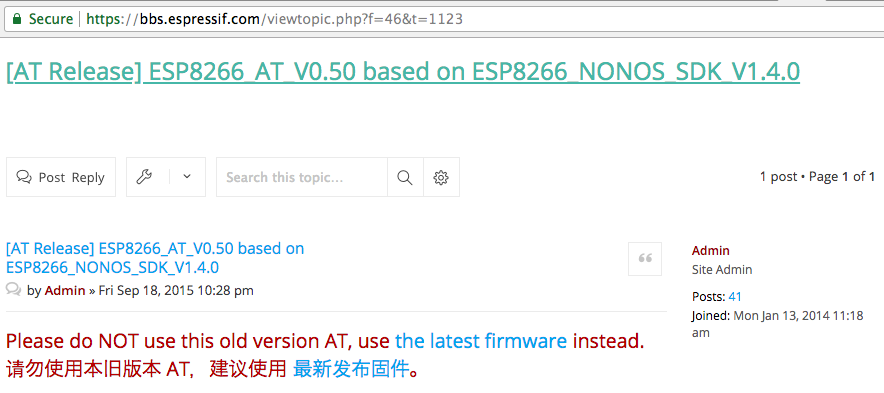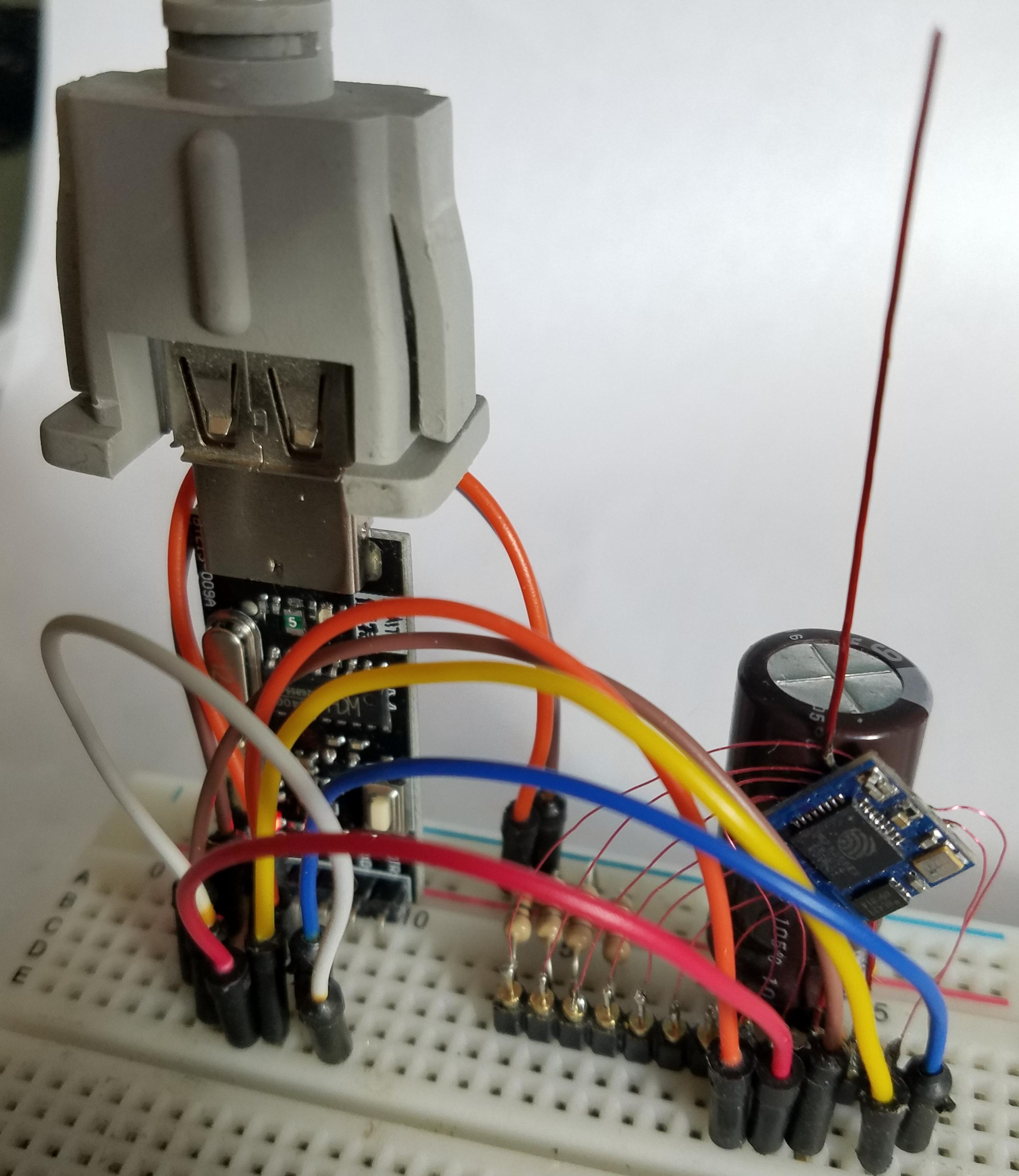Espruino on ESP8266 ESP-09 - 1 powerful cm2 #1003
Replies: 4 comments
-
|
Posted at 2018-10-26 by @allObjects *** NOTE *** Baudrate: Use To get something going, I started out on the https://www.espruino.com/ESP8266 page. The regular test code that connects to the module and then to my local wireless LAN threw only something like ...no ready after reset in my face. Reading up hinted Espruino module or baud rate. Module change did not help. So I used the code to discover the baud rate... this though did not help either... Since it did not talk back at all in this baud rate discovery code - I got empty string back for all of the listed baud rates, I wondered if really nothing comes back or the discovery code is just not up to task. Several actions I took:
Now got something going... right after the reset to the point where I got input buffer overrun. In other words the module was not dead... the baud rate discover had the reset short coming... sending code with different baud rate without reset did not produce anything but empty string. With the reset I god information, but still all gibberish... When I initially worked on the module a couple years ago, I had used an oscilloscope and figured empirically by just looking at the signals that there was a baud rate of something 76400... searching around, I notice that others encountered 76800. Therefore I added this baud rate as well to the list of others. This is the final discovery code: Now I got something legible back... proper mode - 3 - but other than that, not very nice: very old version of firmware... something like I tried now - with 'proper' baud rate different versions of the ESP8266 module with no success... all failed with something like To get more information, I updated python from 2.7.5 to 2.7.15 and got the esptool in python installed from https://github.com/espressif/esptool - I would need it anyway for updating - and I did some reading using PICO as the mediator - or - USB to Serial. This is the modified 'bridge' code i used: In bootloader mode, esptool could read the chip_id and flash_id. The chip_id showed ES8266 as expected, but the memory showed 8Mbit - 1MB. and It took though always two attempts after a power connect. The first choked in the esptool on the double listing of the USB to Serial device I usually connect to the second one... so I tried the first one, and it got worse: python claimed that the device would be busy and cannot be opened and read from... Now I was looking for updating the ESP8266 ESP-09 module... and found the 0.50 - declared old by espressif, but tested by @gordon... - https://bbs.espressif.com/viewtopic.php?f=46&t=1123 After successful flashing, I was still not successful to connect to the device... same error: My last shot was now something a first for me: put Espruino on a non-Espruino board... something I was always discouraging people to do, because ESP8266 is just not the right setup... Taking the combined binary and ignoring the extra 512KB in the ESP-09 vs the ESP-01, I successfully could flash the ESP-09 - of course - as Murphy wants to be part of the game - only the second attempt was successful: Too lazy to dig up a USB-Serial cable, I switched my Espruino Bridge on PICO to run mode and loaded the bridge - w/ 76800 talking to ESP-09: Great... for the begin... bad gibberish at the end: A via 9600 baud to 115200 got my bridge working and I can see Espruino on ESP-09: There is still some gibberish... until Espruino in ESP-09 switches to 115200, and logo and everything shows nice... Going back to my baud rate discovery shows that some stuff comes in at 76800 and then Espruino switches baud rate to 115200. Next step is really getting this USB-Serial cable out... to test the Wifi part... of course, I could manually load the modules through the console... but that's not fun. I still hope to be able to get back and just drop ESP on ESP-09 rather than Espruino. May be I should have listened to the comment on the espressif page with the AT 0.50.0.0 download - see screenshot. Attachments: |
Beta Was this translation helpful? Give feedback.
-
|
Posted at 2018-10-27 by @allObjects ...long story short - after digging up the versatile USB-to-Serial: Hurray, it just woks: Espruino 2v00 on the mini ESP8266 ESP-09 - 10x10mm (~3/8..0.393..7/16"). See also sister conversation WebServer and Chirp Sensor (moisture, temperature, light) on ESP-09. And console output: Attachments: |
Beta Was this translation helpful? Give feedback.
-
|
Posted at 2018-10-29 by @gfwilliams Wow, nice - and it looks like the aerial works ok? |
Beta Was this translation helpful? Give feedback.
-
|
Posted at 2018-10-29 by @allObjects Aerial - whip antenna - works nice... it is 1/4 wave length (31mm). The -45 degrees ground plane though is missing, so I do not know the impedance... (The original, intended use of the ESP-09 was within an H0 model train engine of metal - an ideal ground plane.) - On the breadboard as pictured, the big fat electrolyte capacitor may help with the radiation with its aluminum case. My wifi access point is actually pretty far away: I sit at one end of the house on second floor and the access point is at the other end of the house on first floor. |
Beta Was this translation helpful? Give feedback.


-
Posted at 2018-10-26 by @allObjects
I had some fun with my with my ESP-09 that had a break for a while... a break of couple years... I got it finally talking a bit more... Attached are the pics of my setup...
To begin with, I just wired the pins for normal run via 10k resistors - GPIO0, GPIO02, RST to H, GIO15 to L - and a direct connection of CH_DP to 3.3V. The 'fat' capacitor - 2200uF - close to the 8266 makes sure that there is enough juice for spikes... As said, this was the beginning... to get things done though, I ended up with wiring more pins to PICO - like in the shim - and override the resistors.
No matter what I did, ESP8266 ESP-09 as a pure Wifi module driven via serial from Espruino just did not want to cooperate. I ended up to put Espruino on the ESP-09 and now we are talking. The third picture shows the final setup: Espruino IDE on OS X connected via USB-to-Serial to ESP8266 ESP-09. For how I got there, keep reading.
See also sister conversation WebServer and Chirp Sensor (moisture, temperature, light) on ESP8266 ESP-09.
Attachments:
Beta Was this translation helpful? Give feedback.
All reactions